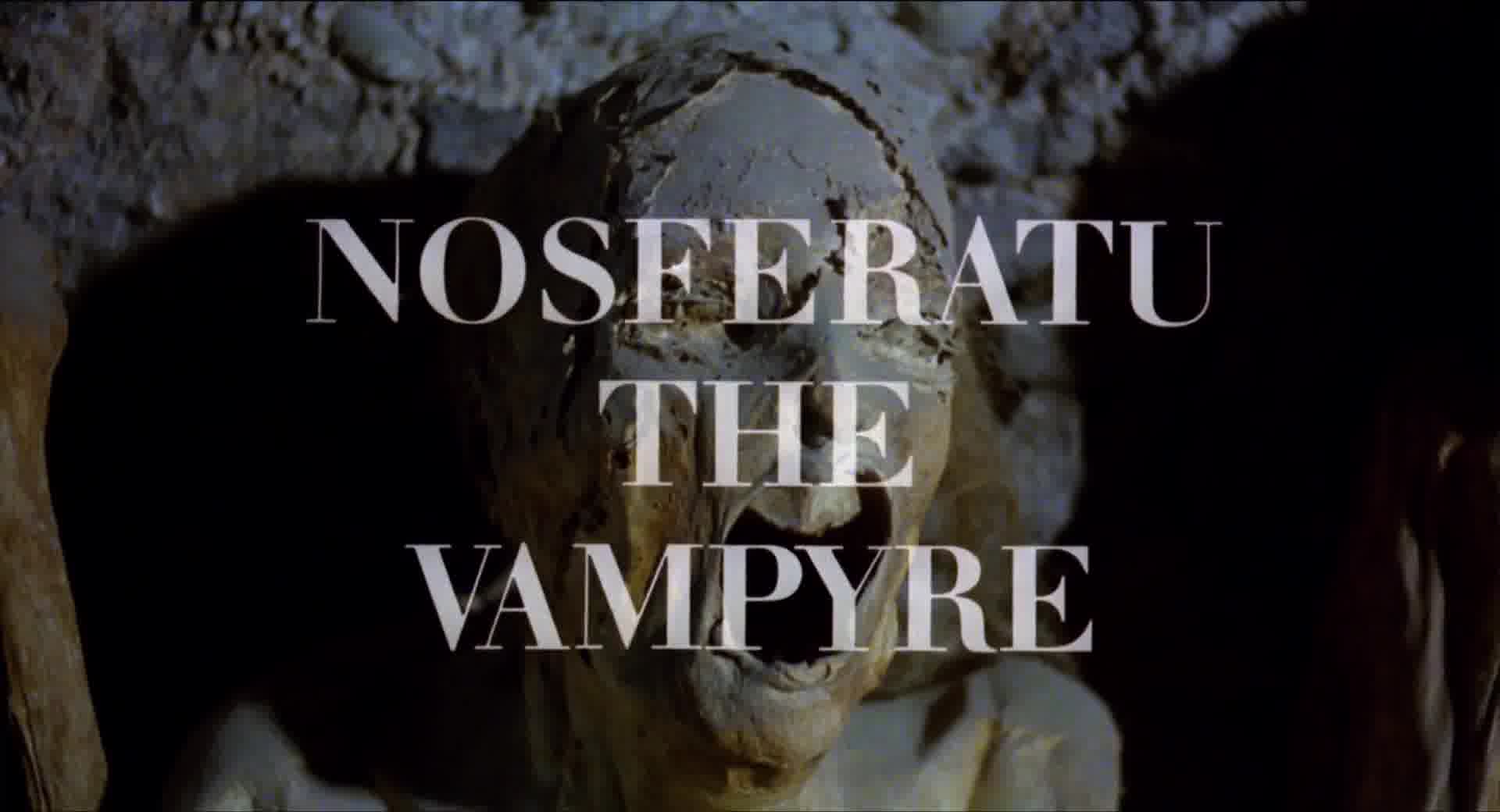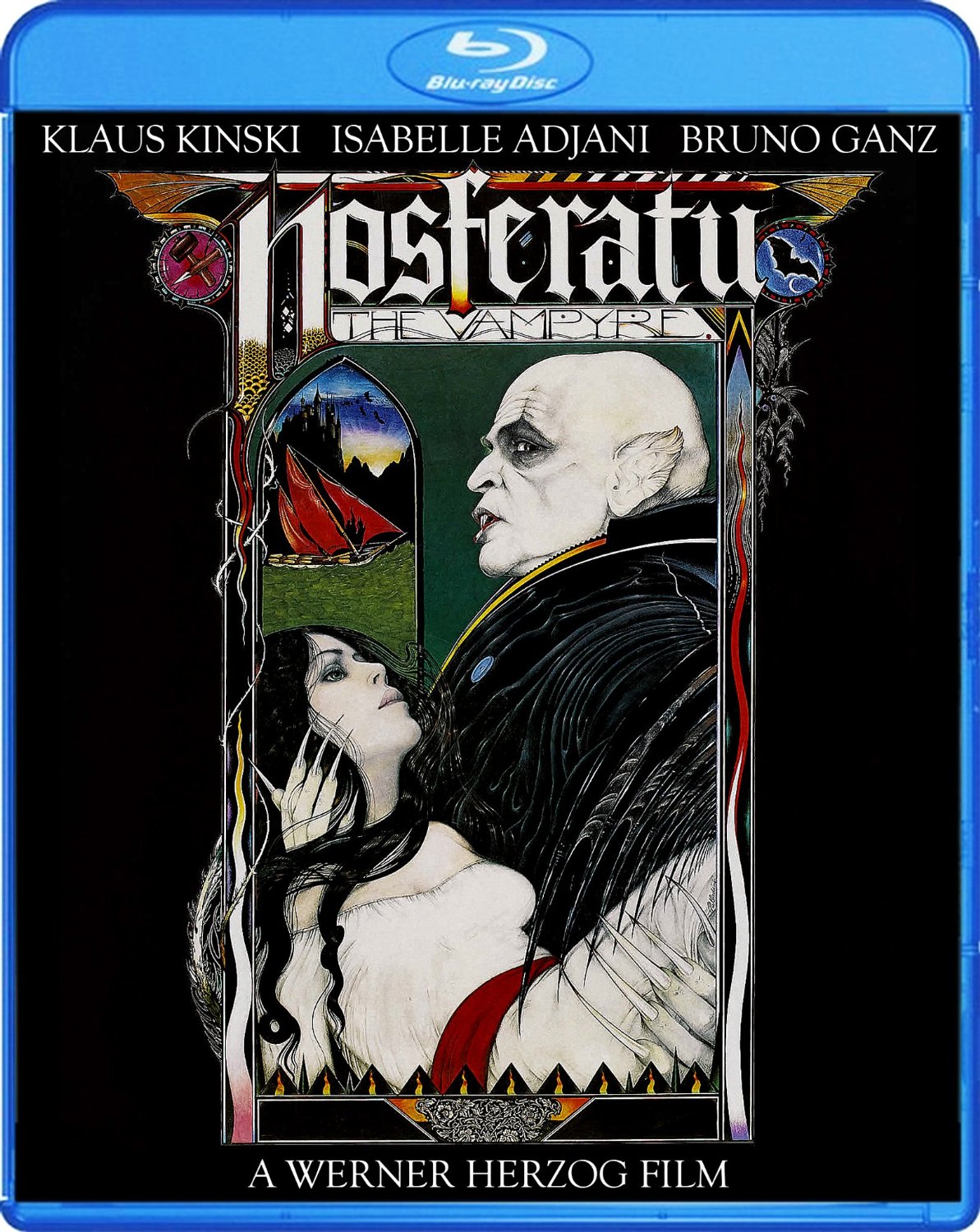
 BUY FROM AMAZON: CLICK HERE!
BUY FROM AMAZON: CLICK HERE!
MSRP $24.97
RATED PG
STUDIO Shout! Factory
RUNNING TIME 107 Minutes
SPECIAL FEATURES
• German and English Versions of the Film
• German and English Audio Commentary by Writer/Director Werner Herzog
• Making-Of Documentary
The Pitch
Werner Herzog’s Dracula, starring Klaus Kinski in Max Schreck make-up.
The Humans
Werner Herzog (Writer/Director), Klaus Kinski, Isabelle Adjani, Bruno Ganz, Roland Topor, Walter Landergast
The Nutshell
It is 1850 in the beautiful, perfectly-kept town of Wismar. Jonathan Harker is about to leave on a long journey over the Carpathian Mountains to finalize real estate arrangements with a wealthy nobleman. His wife, Lucy, begs him not to go and is troubled by a strong premonition of danger. Despite her warnings, Jonathan arrives four weeks later at a large, gloomy castle. Out of the mist appears a pale, wraith-like figure with a shaved head and deep-sunken eyes who identifies himself as Count Dracula. The events that transpire slowly convince Harker that he is in the presence of a vampyre. What he doesn’t know is the magnitude of danger he, his wife, and his town are about to experience.
The Lowdown
Living as we are in an era where remakes are nearly as ubiquitous as the people who complain about them, even the most genuinely good films that fall under this umbrella are burdened with answering the question “Is this necessary?” The need to validate a remake’s existence comes from the assumption that a movie is being remade due to some short-coming of the original; this is both fair and unfair. Some remakes are an attempt to tell a story with better execution or to re-adapt an existing work in a more faithful way, but that’s hardly the only reason for which remakes are made. Motion pictures are the natural descendant of plays and plays were and still are performed numerous times with different actors and directors, sometimes even at the same time. Of course, the entire selling point of motion pictures is that they capture a moment in time for eternity, so why do we as viewers need another take on something? Aren’t films like books which are rarely redone for a new audience?
The general consensus is that a remake cannot exist in the same universe as the original without being in direct competition with it (and sometimes with several other versions). This has become problematic as more and more remakes are being done of recent films from other countries. It begs the question that if a movie is good, is it rendered automatically less good because it isn’t original? Even a shot-for-shot remake has a unique feel and style that belongs to the creator of that respective version (as anyone who has seen Gus Van Sant’s atrocious Psycho remake can attest) so just because a remake is less original than its predecessor, it can still be creative and worthy of its own artistic merit.
I’ve made this point so I can say, in a roundabout way, that I see no value in comparing Werner Herzog’s Nosferatu the Vampyre to F.W. Murnau’s classic silent horror film Nosferatu. Herzog claims that his movie is not a remake of Murnau’s film but a “retelling” because, presumably the Germans have no word for “synonym.” Herzog’s movie reuses shots, lines, and possibly even locations (he can’t quite remember) and apes Max Schreck’s famous make-up for Klaus Kinski’s Count Dracula, it is unquestionably a remake. But F.W. Murnau’s Nosferatu is the Great White Shark of horror movies, it’s not terribly elegant or beautiful but it is so perfect at what it does that to try and improve upon its design would be to take away from it’s simplistic perfection. It may well be the best horror movie ever made and comparing any other horror movie to it is a long circuitous and tiring argument that’s not even worth having. So to hell with how it stacks up to Nosferatu, is Werner Herzog’s Nosferatu the Vampyre any good?

“Motherfucker, did you just call me Voldemort?”
Well… yes. I’m going to be honest here, Dracula is one of the most oft-adapted novels in the history of cinema and, though each version has its merits, they all are pretty awful (Yes, even the Francis Ford Coppola one, especially that one). Part of the problem is that the ingenious way the book plays out (in newspaper clippings and journal entries) can never properly be brought to film without spoiling the magic of how the story unfolds, but the other part is that most directors get hamstrung by romantic notions, eroticism, and grand guignol and forget what really makes the story work so well: dread.
Herzog can be a polarizing film-maker but one thing he always brings to the table is a fresh perspective. He cherry-picks the best bits of Murnau’s film, Stoker’s novel, and puts his own spin on it to create what in my opinion is the best version of the Dracula story brought to screen (at least the best one where the character’s name is actually Dracula). While he uses the expected wolf howls, bats, and frightened peasants that other adaptations have made into tropes he brings in other foreboding elements to the story that aren’t immediately noticed but give a disquieting sense.
The closer Harker comes to Dracula’s doom fortress on Mt. Creepydark, the more foreboding the scenery becomes but not just in usual ways. Shots become more claustrophobic, color schemes change, the music becomes imperceptibly more downbeat. Even the earlier parts of the story are framed in odd ways that put the camera at a distance or include more details than necessary which puts the viewer off guard.
When the second act of the movie happens, everything becomes dreamlike and surreal. Colors are muted, there’s a hazy quality to the shots, people dance amongst coffins in the town square while fires burn and farm animals run free. Things feel apocalyptic and hopeless and it begins to feel like our characters are the only ones left alive on Earth. I don’t get these feelings from any other adaptation of Dracula and they’re usually trying a lot harder to make me feel them.

“I have the weirdest boner right now.”
Both the German and English versions of this movie are included on the disc, it makes little difference aside from the audio track. What you have to understand is that one is not “original” and the other “dubbed.” Both versions have original dialogue and dubbing as the cast were international and spoke several different languages so while Bruno Ganz sounds a great deal better in the German version, Isabelle Adjani sounds breathy and bored and the opposite can be said of the English version.
The spoken dialogue may suffer in both versions but Herzog picked some exceptionally talented actors for this movie. Bruno Ganz is probably the best realized Jonathan Harker in any adaptation, he’s the right mixture of heroic and clueless to capture the essence of the character. But, of course, Harker isn’t the main character and actually plays a very small part in the second half of the film.
Isabelle Adjani is amazing as Lucy. She’s pale and beautiful in an ethereal way, with large eyes and an expressive face. She conveys such emotion with her face and gestures that she’s able to carry most of the movie on her own shoulders.
And then of course Klaus Kinski as Nosferatu is a casting decision that makes far too much sense. Kinski is the only character with a good performance in both versions of the movie and he sells it well. This take on Dracula is a bit unique to this version and it’s a take I fell in love with instantly. Dracula has been a vampire for a very long time and hasn’t been in contact with a lot of people during this time, he’s more of an animal than a man in many ways. Dracula is dangerous but he’s not malicious, vampirism isn’t something that’s made him evil, it’s just made him hungry and he can’t resist it. Still, as animalistic as he’s become, he’s still a man deep down and he wants for tenderness and company, love, friendship, joy but he can’t get those things because he’s a violent predator. Kinski’s Dracula is creepy, but he comes across as shy and out of touch with the world. The supremely creepy scene where he sneaks up on Lucy and introduces himself soon takes on a pleading tone as he all but begs her to love him. It soon becomes apparent that Lucy has the upper hand in her dealings with Dracula but he’s still terrorizing the town because he brought the plague with him.
Lucy and Dracula’s relationship subverts the connection the vampire and the damsel typically have. In most versions the vampire has some sort of mesmer over the damsel which causes her to become attracted to him and there’s a very romantic and erotic notion to the eventual bite. What’s always bothered me about the way that’s typically handled is that a vampire’s bite is an easy metaphor for rape, so seeing a woman moaning in painful ecstasy as she’s being metaphorically raped by the villain of the piece has always skeeved me out more than a little. But here, the only way Lucy can beat Dracula is to trick him and she uses his lust for her to do this. The bite scene is extremely salacious, but unlike in other versions there’s a reason for this. Lucy makes him think she’s giving in to him and he buys it because he’s desperate, to him it’s a very tender and erotic moment and it shows in his body language but not in her wide-eyed stillness. Dracula is a monster and there’s no doubting this but because of the emotion behind the brutishness, the damsel (who is secretly the hero) actually makes a victim of the monster.

Meanwhile: In the Antebellum South…
I had some problems with this movie on my first viewing. The film is very fast-paced but still lingers a lot so as to make it feel slower, on a repeat viewing I appreciated the reasoning behind this slow start but you may have similar problems; particularly if you’re used to the Hollywood studio model of something overtly happening all the time.
Nosferatu has its shortcomings but it’s put together in such a way that they don’t diminish from the movie as a whole. It’s a film about mood and emotion more than occurrences and has a sort of pop art or beat poetry feel to the way the story progresses. It’s both minimalist and yet richly detailed in a way that’s hard to describe. The scenery is beautiful and wonderfully shot, the image quality is amazing (even for a remaster from this era) and it has a look that is very unique. How Nosferatu the Vampyre stacks up to Nosferatu is irrelevant; it’s just a very good movie.
The Package
Special features are light but there is an audio commentary that is very worthwhile, listening to Werner Herzog talk about film-making is always a worthwhile experience and even the insipid questions of the guy hired to keep him talking throughout the film don’t take away from it much. There’s a vintage documentary on the making of the film on the disk as well but it’s pretty skippable.
As always, picture quality is great but there are several scenes that are quite grainy. I think this is likely a flaw with the original film stock as about 90% of the movie is just absurdly crisp for a 70s movie, so I’m not going to pin that one on Shout! Factory.
Rating: 




Out of a Possible 5 Stars